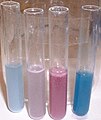Calcon carboxylic acid
| Structural formula | |||||||||||||||||||
|---|---|---|---|---|---|---|---|---|---|---|---|---|---|---|---|---|---|---|---|

|
|||||||||||||||||||
| General | |||||||||||||||||||
| Surname | Calcon carboxylic acid | ||||||||||||||||||
| other names |
3-Hydroxy-4 - [(2-hydroxy-4-sulfo-1-naphthyl) diazenyl] -2-naphthoic acid ( IUPAC ) |
||||||||||||||||||
| Molecular formula | C 21 H 14 N 2 O 7 S | ||||||||||||||||||
| Brief description |
dark purple to black solid |
||||||||||||||||||
| External identifiers / databases | |||||||||||||||||||
|
|||||||||||||||||||
| properties | |||||||||||||||||||
| Molar mass | 438.41 g mol −1 | ||||||||||||||||||
| Physical state |
firmly |
||||||||||||||||||
| Melting point |
299-301 ° C |
||||||||||||||||||
| safety instructions | |||||||||||||||||||
|
|||||||||||||||||||
| As far as possible and customary, SI units are used. Unless otherwise noted, the data given apply to standard conditions . | |||||||||||||||||||
The Calconcarboxylic is an azo dye which in the analytical chemistry for complexometric determination of calcium is used. Structurally closely related is the water-soluble dye eriochrome blue black R or calcon , which can be obtained from calcon carboxylic acid by decarboxylation and reaction with sodium hydroxide .
properties
Calconcarboxylic acid is insoluble in water; in ethanol it dissolves with a purple color. It dissolves in alkali hydroxide solution, forming a salt with a blue color.
Use as an indicator
Calconcarboxylic acid forms red complexes with calcium ions . It is therefore used in complexometry as a calcium-specific indicator . For this purpose, the sample dissolved in water is mixed with potassium hydroxide or sodium hydroxide solution and the indicator (e.g. as a 0.4% solution in methanol ) and titrated with EDTA until the color changes from red-violet to blue : Calcium also forms a complex compound with EDTA which, however, is much more stable than the complex with calcium carbonic acid, so that the calcium is gradually converted into the EDTA complex when EDTA is added. The red color of the calcium carbonic acid complex disappears when all the calcium is present as an EDTA complex. The amount of calcium originally present can be calculated from the amount of EDTA added up to the color change.
The potassium hydroxide solution is added to precipitate magnesium as a hydroxide . If magnesium were in solution, the EDTA complexed not only calcium but also magnesium instead. Thus one would have to add more EDTA until all of the calcium is complexed; the result is thus falsified.
Reacts with the ions of the other alkaline earth metals
The reaction of calcium carbonic acid with calcium is only specific to a limited extent. Also, barium and strontium form red colored complexes. The two following images show the four alkaline earths (barium - strontium - calcium - magnesium) separated in an aqueous solution after adding the indicator:
- in the left picture with potassium hydroxide:
- The solutions with barium and calcium are red, with strontium deep red; Magnesium does not react with calcium carbonic acid, so that its blue color shows up.
- in the right picture with sodium sulfate and potassium hydroxide:
- Barium and strontium sulfate have too little solubility to form a red complex with the indicator. Only the calcium solution is red.
Individual evidence
- ↑ Data sheet Calconcarboxylic acid from Acros, accessed on February 19, 2010.
- ↑ Data sheet Calconcarboxylic acid from AlfaAesar, accessed on January 18, 2010 ( PDF )(JavaScript required) .
- ↑ a b data sheet calconcarboxylic acid (PDF) from Carl Roth , accessed on October 9, 2018.


